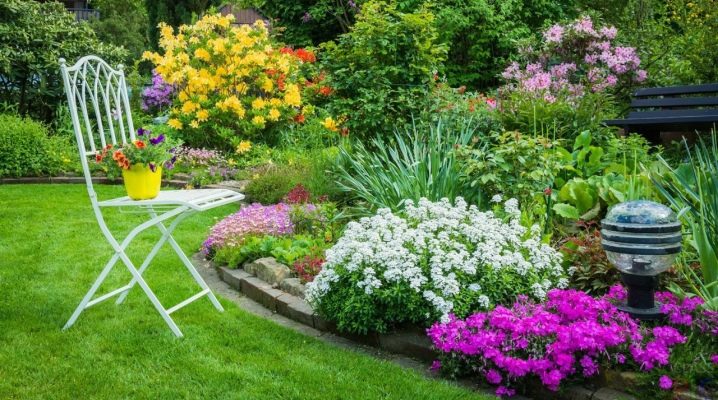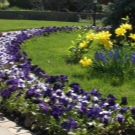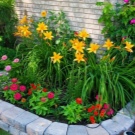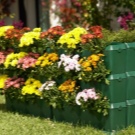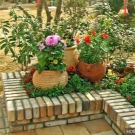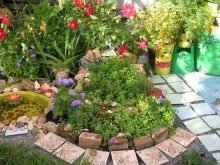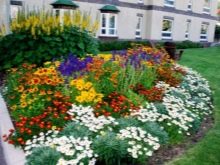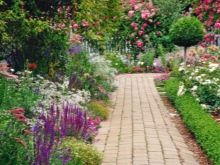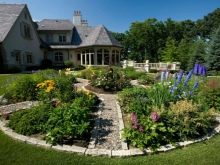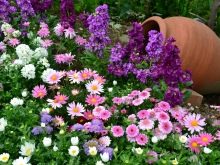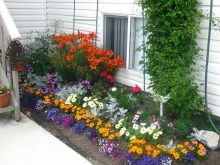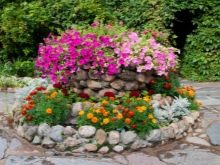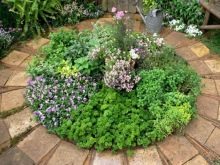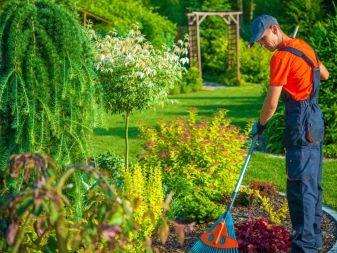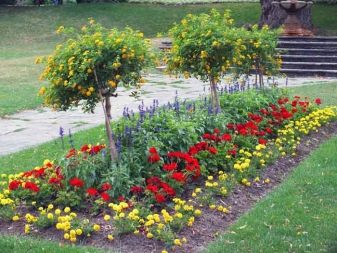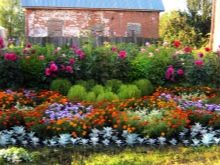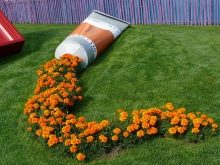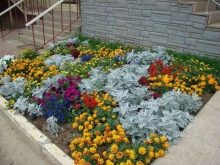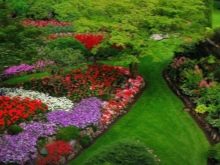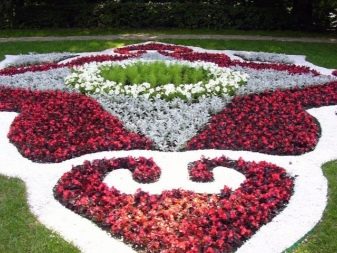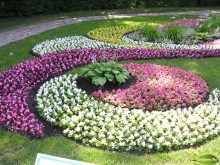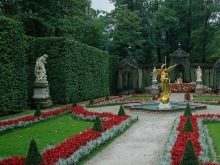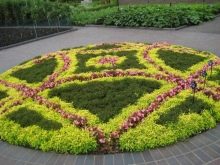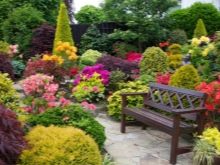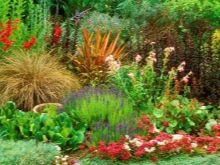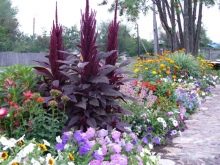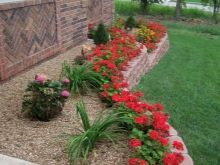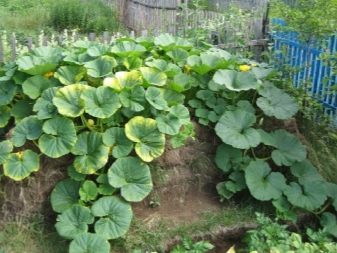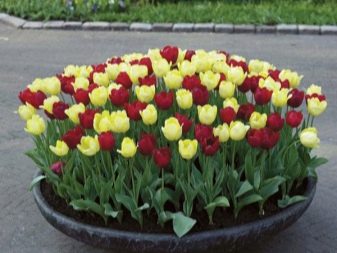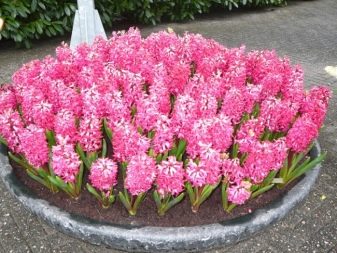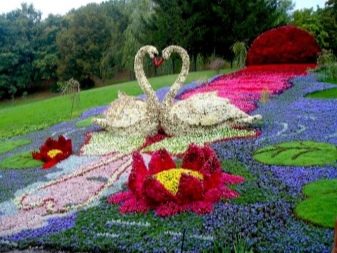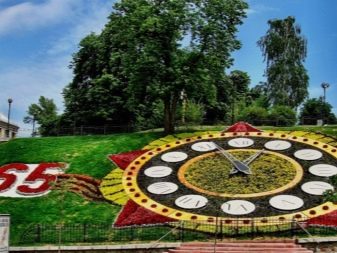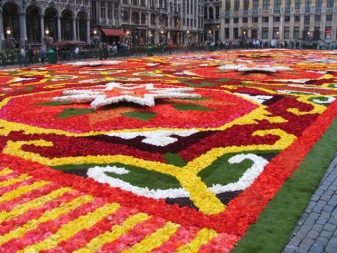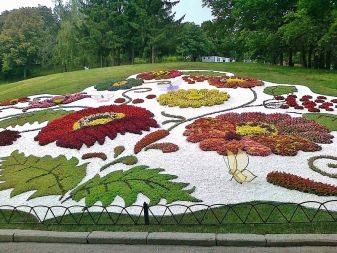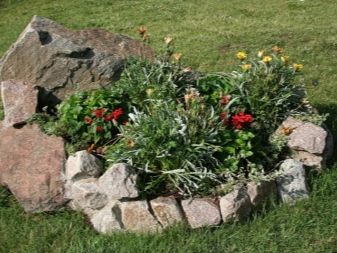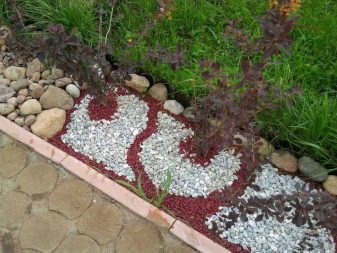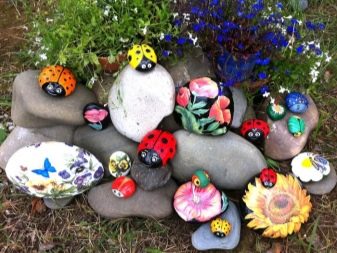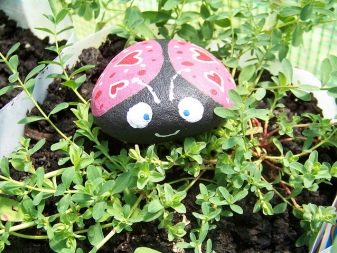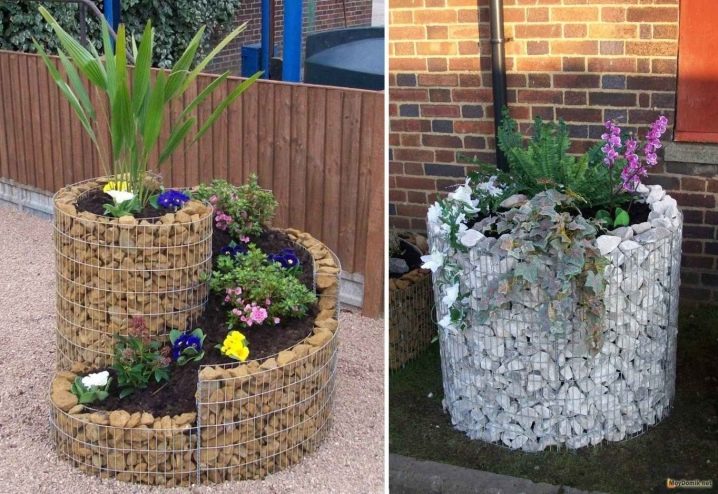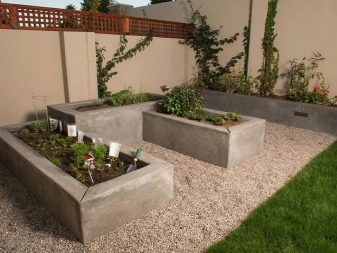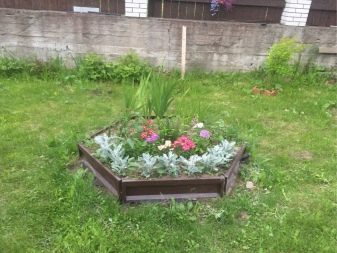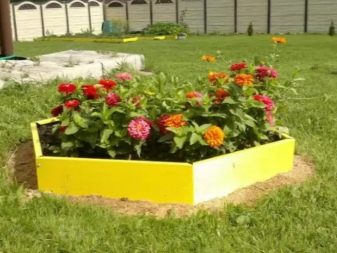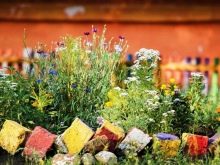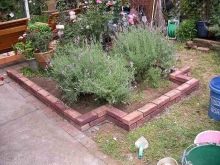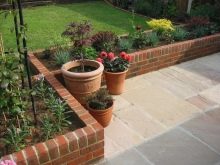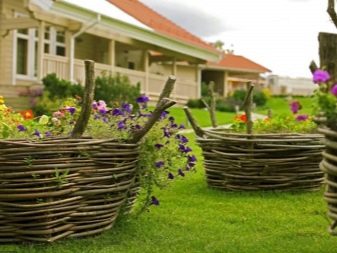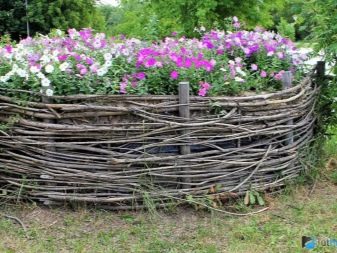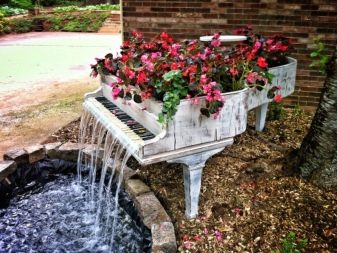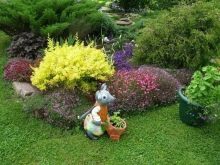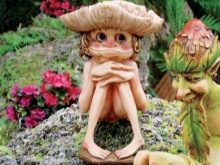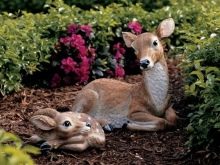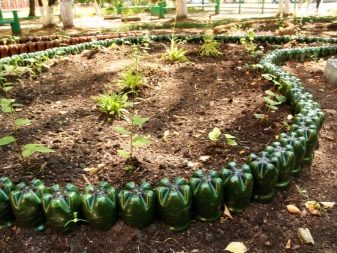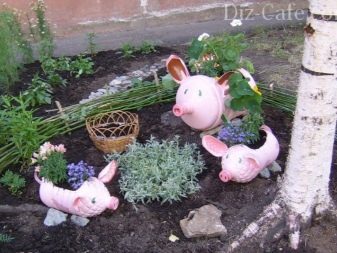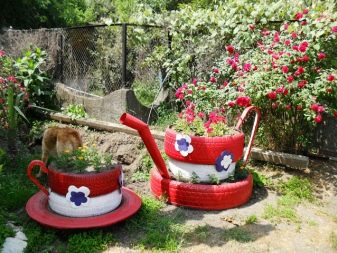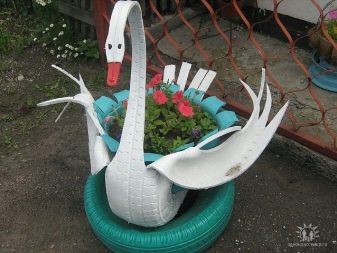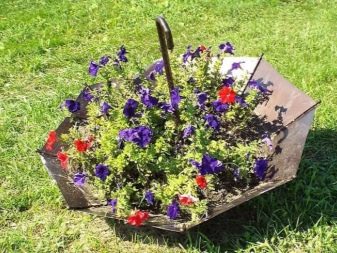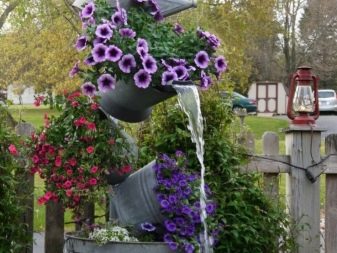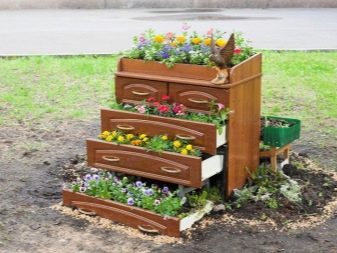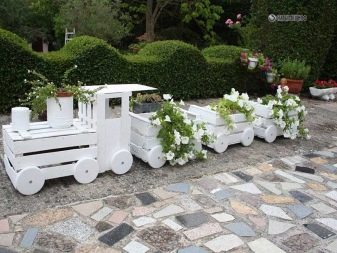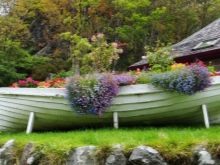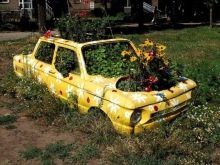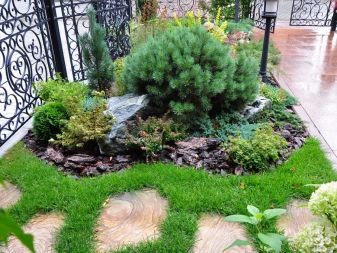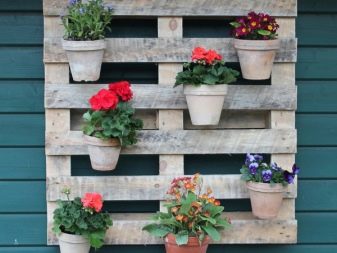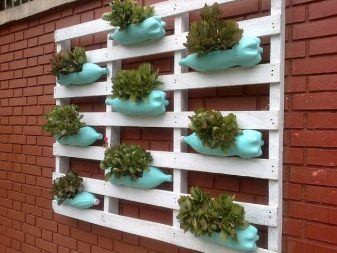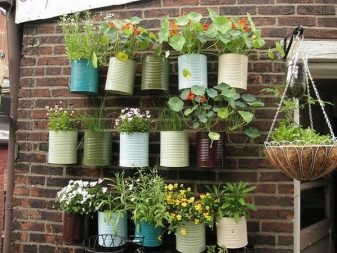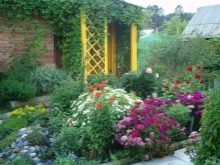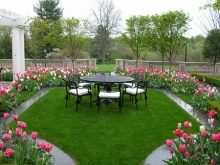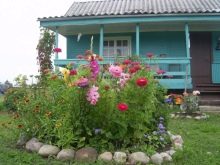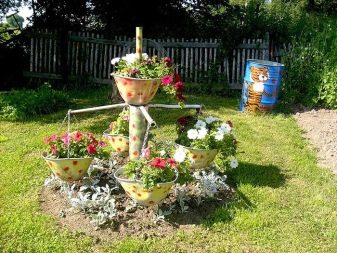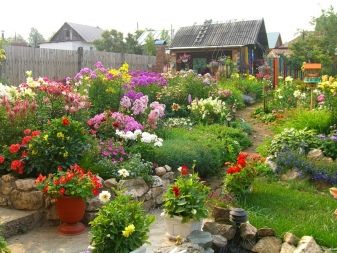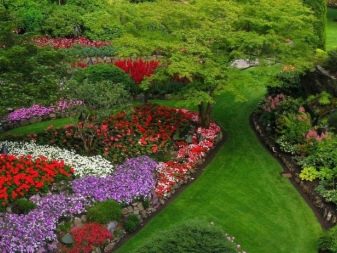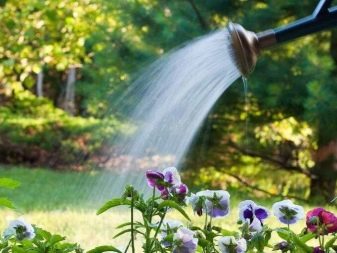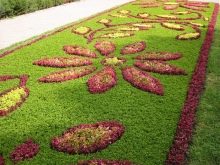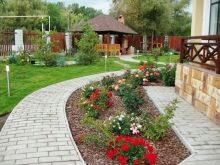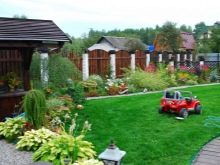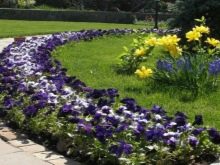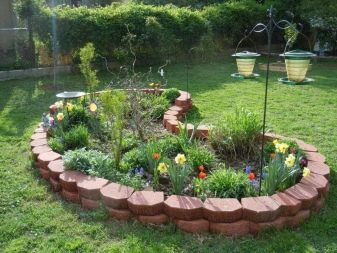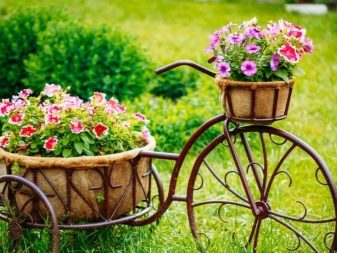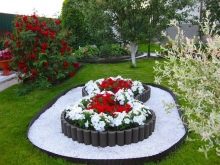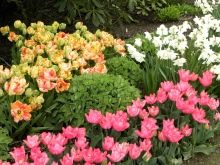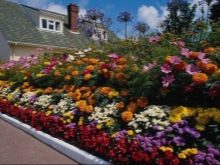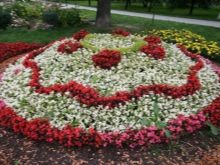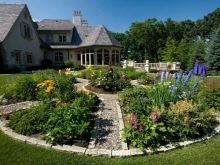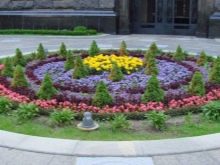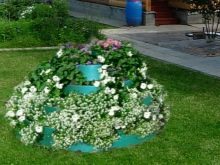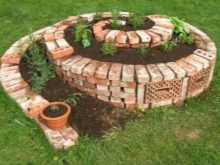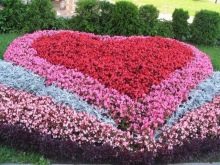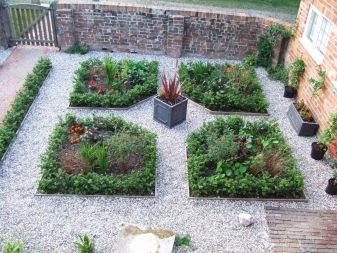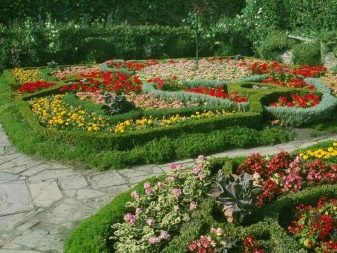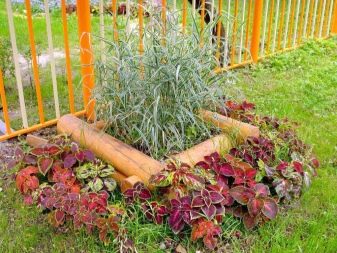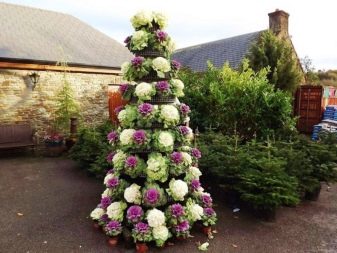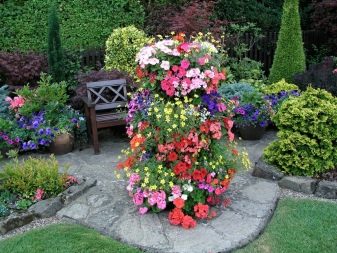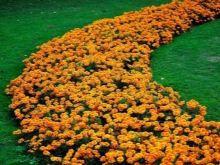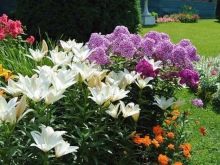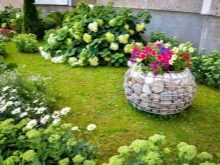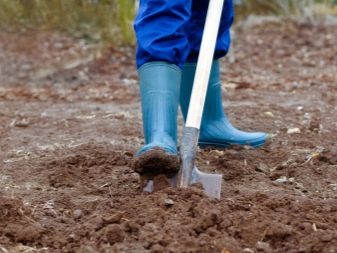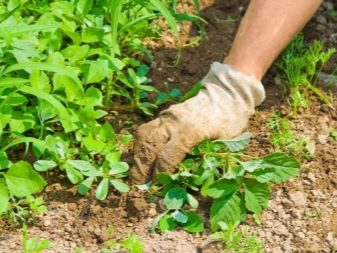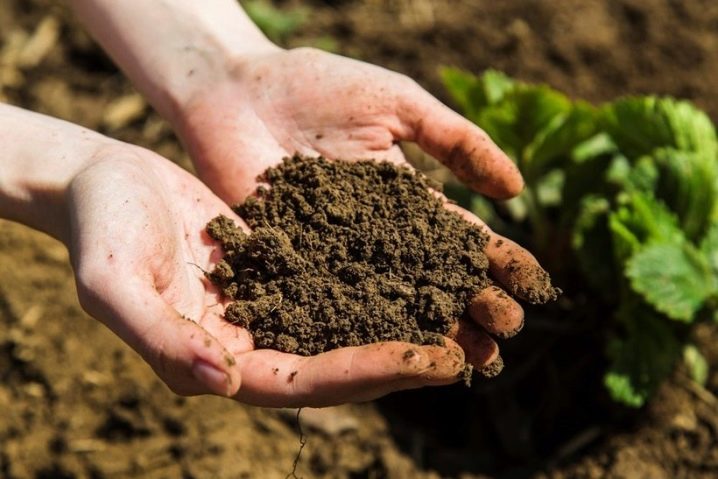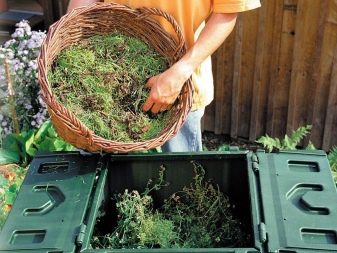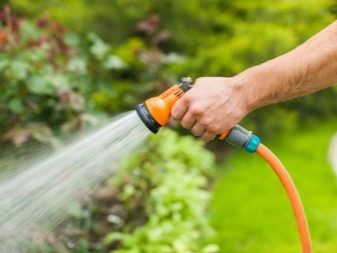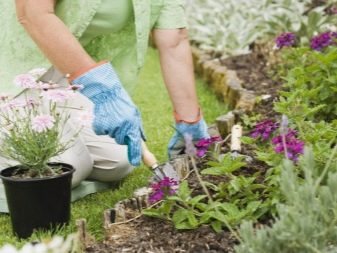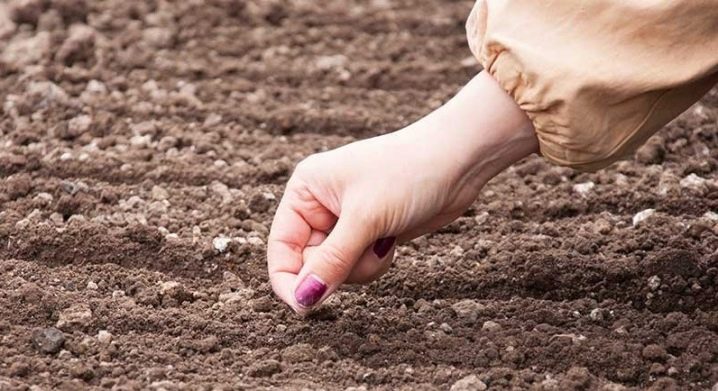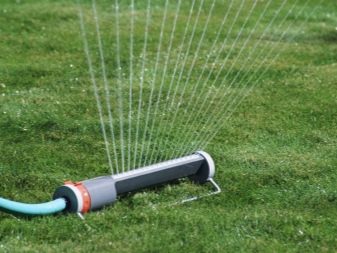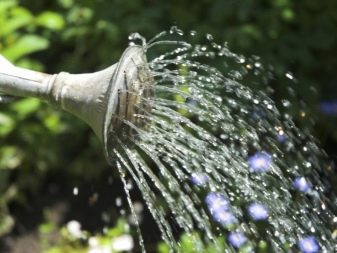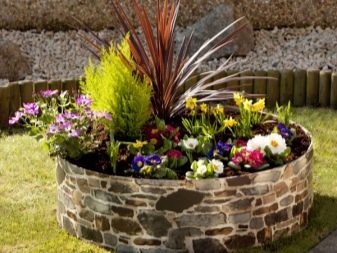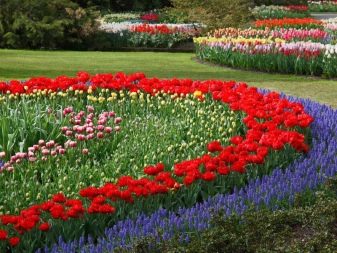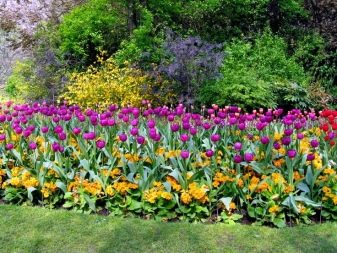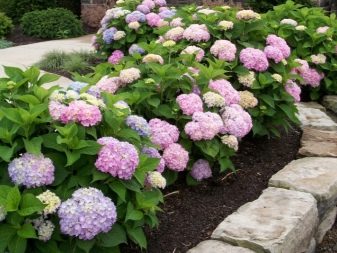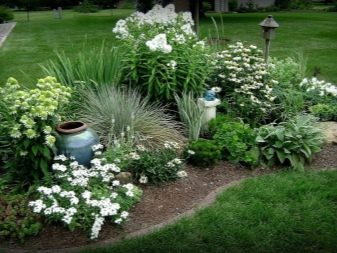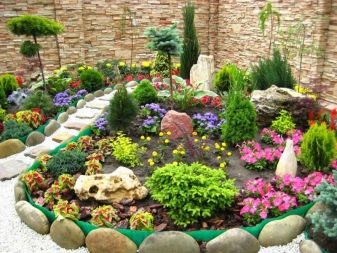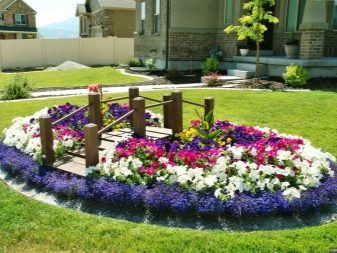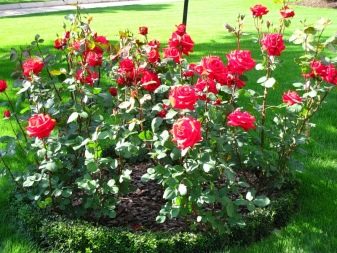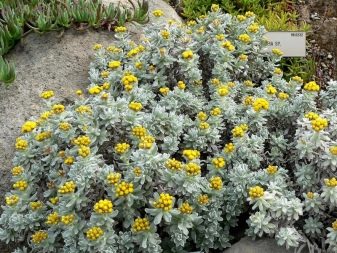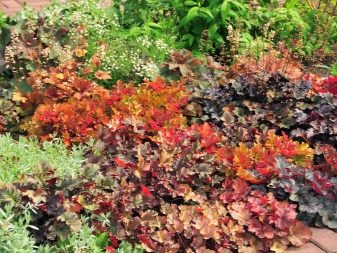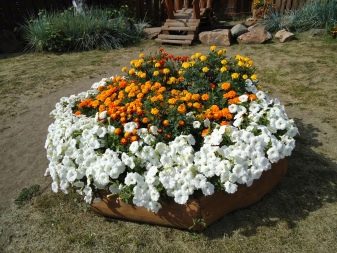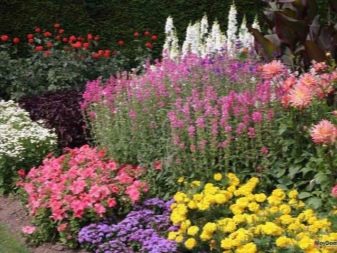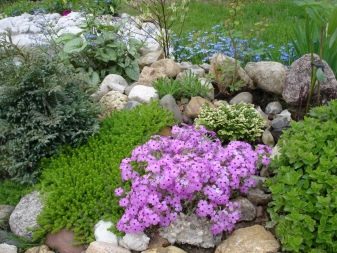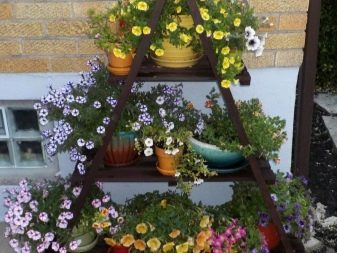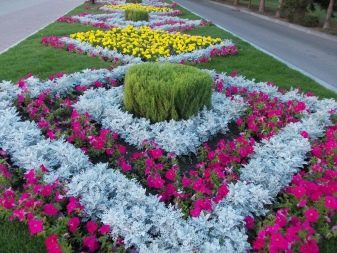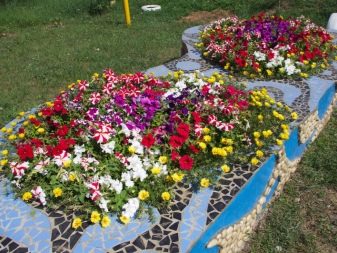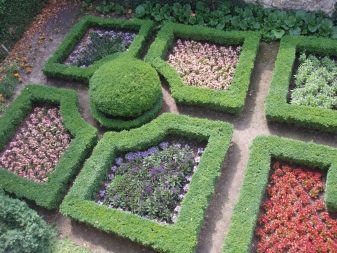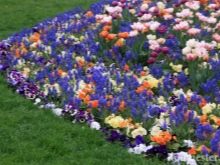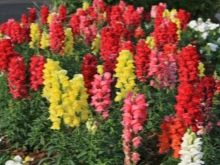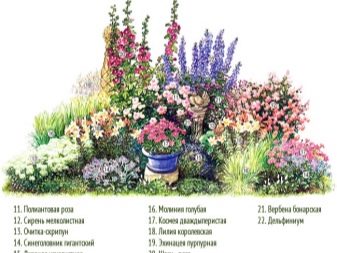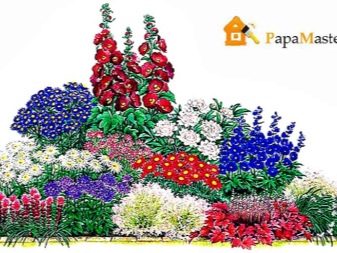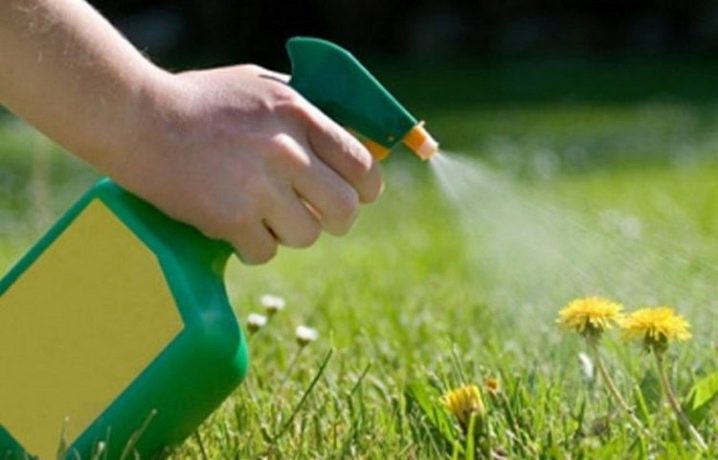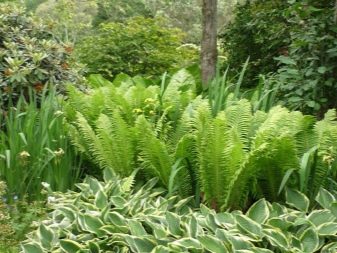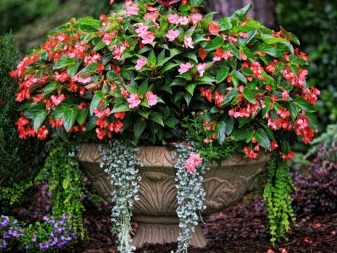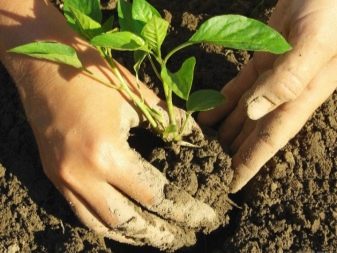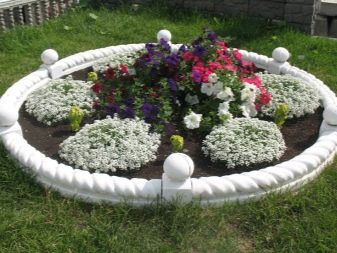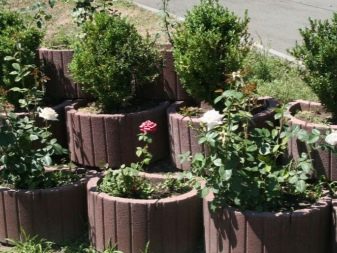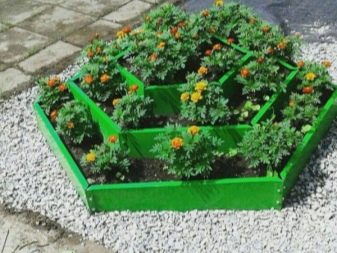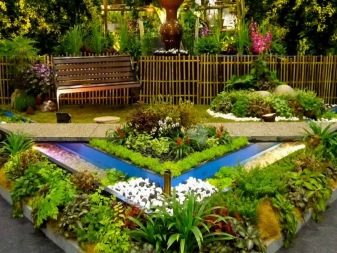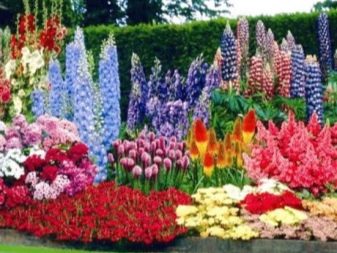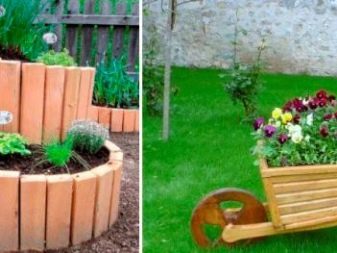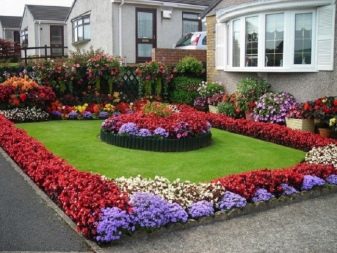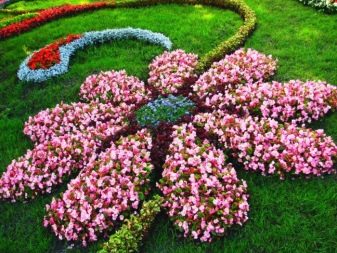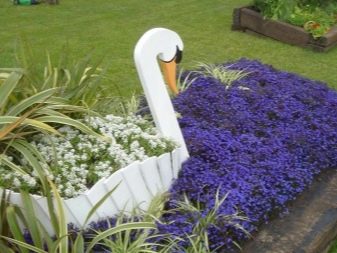Beautiful flower beds: features of planning in landscape design
In the design of any landscape design one of the leading places occupied by flowers. They are placed in flowerbeds, which must be created taking into account the characteristics of each type of plants growing on them. About these features and will be discussed in this article.
Special features
The plot of each private house or house territory has its own unique parameters. Before you break a flower bed, you need to make an initial plan for the placement of future crops and plantings.
In order to correctly calculate the time of full ripening and flowering of planted seeds by seasons, best to use ready-made layouts. They can be found in books on floristics or, if there is no desire to delve into this topic at all, use the services of a professional landscape designer.
When planning the land space for a flower bed, you should remember about your own convenience. The distance between the rows and convenient access to each of them will provide maximum comfort for the owner. This is very important, since accessibility affects the full care of plants. In the case when a person cannot reach any of the beds, a full-fledged and high-quality treatment cannot be carried out, but only a superficial one.
Do not forget about the human factor. It may just get annoying every time to stretch and strain to remove fallen leaves or petals, as often happens.
With proper arrangement of plantings in a flowerbed, even on cold days, plants will delight you with their beauty. For example, among the snow they can bloom with its greenery a hellebore, western thuja, deren.
Autumn time is a cold season. An excellent solution would be to grow a bed of medicinal plants that will help to cope with the first symptoms of indisposition. It would be nice to even take a separate "medical" flower bed. There you can grow chamomile, lavender, lemon balm, sage, calendula, thyme.
Very often novice gardeners make a large number of mistakesthe most common among them is to plant all the flowers at random or on the principle of “like - don't like”. In this case layering and proximity of plants may be affected. Due to the illiterate arrangement of flowers in height, shading of the space is possible, which will have a bad effect on the development of low-growing plants.
Do not forget about the soil. As a result of its wrong choice, the inflorescences will not be able to please their host in all their glory.
Landscape designers advise zoned area flower beds. In this way, a combination of various types of flowers and bushes can be achieved without harming each other.
It is worth paying attention to the issue of timely cleaning of the soil from faded blossoms and weeds. Weeds spoil not only the appearance of the plantings, but also the very life of the root system and the flower as a whole. Systematic cleaning helps to avoid problems with pests and natural debris.which is formed as a result of the life of flowerbeds.
It is very important to weed beds in a timely manner so that there is no thick and coarse earth crust. If it is not removed in time, the roots will have nothing to breathe, and this can lead to the death of the root system and the flower in the future. The land should be well-groomed and loose.
An important aspect is the seasonal fertilization of the soil.In the course of growth and development, the seed or bulb feeds on macro- and microelements that are in the ground. If it is rich enough for them, then the first shoots will not take long to wait, when it is scarce and empty, the crops may not grow at all.
Keeping a calendar of flowering and harvesting will be an excellent solution to save time and effort. According to him Flowers should be planted with a small interval - about a week. So the owner of the flower bed will have time to care for each species without haste and fuss, which will instill more love for such a difficult task.
Types and forms
Today there is a large variety of forms and types of flower beds, which delight with their uniqueness and originality.
First of all, it is necessary to understand what a flowerbed is. This is an artificially designated piece of land that has a clear shape, structure, and a certain arrangement of flowers and shrubs. Most often, it occupies a dominant place in the overall picture of the flower garden. They can be divided into two types - floral and carpet.
The flower bed is distinguished by the fact that both annual and perennial flowers and shrubs are planted on it, so it can bloom all year round.Of course, herbaceous or deciduous plants can be planted to give it pomp and volume. Often it has a multi-level structure and a large species diversity.
As for carpet beds, mostly suited flowers are planted here in height and flowering period. From the name it can be understood that they resemble a flat carpet, in connection with this, such a flower bed is often cut so that the color sheet is even and well-groomed.
The following classification of flower beds is based on the period of flowering of plants and shrubs. Flowerbeds are regular and irregular.
Regular called those that contain plants that bloom at the same time. As a rule, they have a rectangular, square or round shape, as the pattern must also repeat clear geometric shapes. Otherwise, such a flower bed will look rude and have a chaotic and uncomfortable picture for the eyes.
It should be located in easily visible places, that is, not in the corner or on the edge of the plot, but in the middle or in the center of the flower bed.
If it is an irregular flower bed, then preference is given to naturalness and proximity to nature.Flowers and shrubs are planted with small islands and may have a multi-level structure.
This type is most popular among florists and gardeners, as it is easy to care for it, it does not require much attention and time.
Unusual in its performance is a raised flower bed. It is unique and interesting in that it can be multi-layered, where each subsequent upward layer is separated by a wall of brick, decorative stone or wood and can have different shapes.
Semicircular and arranged around one axis (in the form of a triangular spring) tiered flower beds look very nice. The height they can reach up to 1.5 m, ranging from 25-30 cm. It is convenient because it does not need to bend over much when it is fertilized, loosening and other care for the earth. You can simply put a small stool and calmly take care of the flower bed without a load for the back.
Not only simple flowers can be planted from plants, but also vegetables, such as pumpkin or zucchini. Half-ripe fruits will decorate and complement the flower garden, and will also delight in the fall as a harvest.
From pumpkins very often cut out decorative candlesticks or scary heads for Halloween.Of course, they will stay in a flower bed for a short time, but they will delight with their appearance.
In the gardens of professional flower growers you can find vertical flower beds. This is an artificially raised container for plants where climbing or liana-like plantings are planted. So you can create the effect of a wave or waterfall. In turn, it is also easy and pleasant to take care of them and there is no need to bend down and bend over to them.
According to the species diversity, flower gardens can be divided into monoclices and panels:
Monoclumbus they are distinguished by the fact that they contain flowers of practically the same color tonality or only a certain type of flowers. For example, a flower bed can only be planted with roses, tulips or chrysanthemums.
Flower bed panel used to create a picture. If even a novice can cope with the creation of the above-mentioned bed, then a certain level of knowledge and skills is required. The main goal is to display a certain pattern (for example, a watch or a face of a cartoon character, a flower shape, etc.).
As plants used dwarf or low-growing shrubs, as well as perennials. This may be a violet, zinnia, Erica, fuchsia.
Most suitable for urban plantings are carpet beds. They create patterns mainly from deciduous and undersized bush plants with an unusual carved or colored leaf. They require careful and professional personal care, but the result is worth it.
Original decor
In the world of landscape design, there is a large species variety of decorative elements for flowerbeds. The limitation is only one's own imagination and, of course, the financial side of the issue, since this pleasure is by no means cheap.
Stones
Perhaps one of the easiest and most durable ways to decorate a flower garden is to use stones. Stones can be both purchased and found in nature. Often gardeners gain round pebbles on the stone sea coasts.
Some masters paint them with acrylic or oil paints, and then spread them on flowerbeds so that they produce an interesting pattern, curls or paths.
Recently it has become fashionable to decorate the front garden with stones, which depict domestic or wild animals in a hyper-realistic version. It seemsas if a real cat or hedgehog lay down near a beautiful bush of violets or asters.
Handy materials
You can make jewelry for free and without the use of building materials. Land owners take a metal grid and make a voluminous, but hollow inside fence or fence for the beds. Further, all the internal space is filled with a beautiful stone (the same pebbles, sometimes even mixed with shells or decorative glass balls).
Concrete
Professional designers in their projects often use concrete tracks. They are laid in parks, in summer cottages, in gardens, etc. It is easy to move along them without getting their feet dirty.
You can make your own flower from concrete or buy special flower for beds in the store. They are different in height, and also have different shapes (circle, square, hexagon, etc.).
Such devices look very nice and laconic in a flower garden, creating an additional effect of grooming and cleanliness on the site.
Concrete paths in the form of burdock leaves are often made of concrete. To do this, take a large burdock leaf, impose a layer of concrete solution on it and wait for drying.The result is stone leaves of burdock with streaks, like a real leaf.
For greater realism, they can be painted with ink from a can, and the details should be drawn with a thin brush.
Galvanized steel
As a fence for flower beds, galvanized metal sheets are acquired, from which it is easy to assemble a flower bed of any shape. It can be a hexagon, a rectangle, a triangle. Their plus is that they are light and durable. These sides will last a long time, they can change color every year.
Brick
An excellent assistant in the decor can be an ordinary brick. From it is easy to make a decorative frame for flower beds of any shape. Most often, gardeners lay brick angle upthen the “fence” turns out to be very unusual and embossed.
If the plans make a tiered flower bed, then bricks can be laid over the boundaries of the up tiers, which will give even greater charm and accuracy to the flower bed.
For beauty, you can alternate them in color, but if there is no such possibility, then it is better to purchase white bricks and paint them with spray paint.
Art of weaving
A very unusual and as close as possible to nature is the decoration of flower beds with the help of wicker fencing. Wicker hedges are made very simple, although this work is painstaking.
This requires small wooden pegs, and thin twigs of birch, willow, grapevine, willow and even raspberry are suitable as a twig. With their help, you can create a truly unique and unusual flower beds with ornate pattern. Such a “live” decor will always please the eye with its unusual and unique shape.
Sometimes as a braid acquire the coils of thick twine. It will last a long time and help keep the branches of the trees in place.
Flowerbed - the main decoration
For decorative purposes, a flower bed can take very uncommon "poses." One of these options is to install a flower bed in the form of a fountain. The design itself is simple, but requires careful selection of the place and color. Sometimes large bowls of earth are placed in an operating fountain, which looks very impressive.
The flower bed itself is a decoration of a garden or a park, so its shape can also be non-standard. Split flower beds in the form of a butterfly, the sun, a simple flower and use other options.
Decorative figures and figurines
Plaster figures of different sizes are used as decorating elements.These can be garden gnomes, mushrooms, birds, kittens or any other animals. Some craftsmen acquire plaster blanks and paint them themselves. This method will be cheaper, moreover, it is always pleasant to look at the fruits of your work.
The most important thing is to keep a balance and do not overdo it in filling with decorative elements, otherwise the flowerbed will look tasteless.
In the field of landscape design there is always something new and unusual from a variety of materials. Sometimes raw materials are used that are completely incompatible with a flowerbed, but in fact a very effective design solution is made of them.
Plastic and glass bottles
One of the cheap and affordable options for decoration are ordinary plastic bottles. Of them in skillful hands can make beautiful birds or animals. Also from this material will turn out a practical fence for a bed.
To spend less time on watering, you can bury the container half in the ground with a special hole and fill it with water. The roots of the plants will not be in a hurry to drink it, having saved its owner from unnecessary work.
In some areas there are flower beds made of glass bottles. For their fixation with each other all the same concrete is used. With their help, make beds of various forms. The most important thing is that the glass should be clear and uniform (blue, green, yellow).
Tire covers
For street flower beds, an old tire solution would be a great solution. We all not once met such beds. To make them look original and aesthetically pleasing, they should be washed and painted well.
Often they are made into swans, where the main body is a flowerbed, and the head and wings are made of tires, which also pleases people passing by and the master gardener himself.
New life of old things
For the design of flower beds, you can use unusual materials. This may be an old umbrella or a leaky metal bucket. The umbrella is turned upside down and the earth is poured into it, where plants are planted very easily.
If the handle has a hooked ending, then it can be hung, the result will be a hanging flowerbed.
Original flowerbed can be made from metal or plastic buckets. They are often built with a pyramid so that the flowers hang down on the lower rows or they are arranged in a row so that the colors repeat the rainbow. The limitation here is only your own imagination.
Wooden pallets or wooden boxes can be an excellent source material for creative ideas. Of these, it is easy to create a composite flowerbed in the form of a steam locomotive or a stepped pyramid.
If there is an old, unnecessary small chest of drawers, then it can also be used. All the boxes are moved out, filled with earth and favorite flowers are planted there, the result is a very original flower bed.
It is very important that all the boxes are treated with a solution or a solution that does not allow the wood to swell, or, even better, lay the bottom with oilcloth. But it will be necessary to make holes in it, as water can stagnate and lead to rotting of the roots.
For a large area flower bed must be of the appropriate size. Fans of non-standard design take in the case of boats, disused baths, suitcases, bicycles and even old cars that have already left their time limit.
A bicycle is usually painted in a monochromatic color and baskets or baskets are placed on it, where it is possible to plant seeds.
As for the boat or car, then it is worth considering the fact that it is necessary to take care of the objects too, since wood from moisture swells and spreads, and the metal is susceptible to corrosion for the same reasons.
Lawn
A good way to separate some flowers from others on the flower bed is to use a lawn. The concentric circles of the planted flowers of bright shades with green intervals between them are beautifully combined.
The most important thing is to observe the water balance, because green grass requires a quantity of water different from the requirements of flowers for watering.
Everything for convenience
For those who do not want to bend down once more for watering and cleaning, there is an opportunity to create a wall hanging flower bed from the usual wooden pallet. With the help of dowels it is attached to the wall. It can also be wooden shelves. It is desirable to insert plastic pots in special compartments so that the load is less. Then small flowers are planted in height so that they do not block each other’s sunlight.
Such a design is convenient for several reasons: firstly, it is easy to hide the imperfections of the wall, secondly, it is easy to care for the plants and periodically change the pots in some places.
Landscape designers, persuading people to use plastic and glass bottles for the second time, make a flower bed in a very interesting way. A side opening is cut in the container to fit a flower.Further, it is suspended from the ends of the string and is placed on the wall with screws. Figure and layout can be any (in the form of steps, chessboard, ring or contour of the animal).
The original design and decoration of the beds should be simple and at the same time elegant, so that in such a garden you want to relax your body and soul. Each of the objects should also be properly cared for - cleaning from dirt and dust so that the flower garden will delight you with its freshness and colors.
Where to place?
The location for the location of the flower bed must be chosen very carefully. First of all, it should be well viewed in order to fulfill its original task - to satisfy the aesthetic needs of the owners.
If the flowerbed is located somewhere in the corner of the plot, then there will not be any special sense in its location. Of course, you can put a bench next to her and go out to admire her, but in a cool time it is always more pleasant to contemplate the beauty from a warm home than from the street.
In connection with this, the best position for her will be a place by the window, next to the gazebo, near the gate or next to the benches.
The second important aspect is the sunlight. A light day should cover the sown land as long as possible., as it is the basis of full bloom. But then you need to plant light-loving plants, otherwise they can simply “burn” from bright rays.
And the third aspect of choosing a place for a flower bed is the soil moisture. It is safe to say that this factor is much more important than light.
If shade-loving plants can somehow come to terms with bright light, then they will not be able to put up with excess moisture. It is best if the soil is slightly dry and loose., as it is always better to water once more than the roots will rot in the mud slush.
In most cases, the flowerbed is divided almost in the middle of the land plot allocated for a flower bed, or it stretches along a fence or wall of a house in a narrow strip.
Some lovers to break the flower beds "in a big way" make it almost the entire plot. This may be some kind of selected ornament or pattern, but for this you will have to apply a lot of strength.
The beds stretched in length with an approximate width of 1–1.5 m are usually located along the entire length of the intake line (either inside the plot or outside; there are cases when both there and there). These flower beds are called discount.
Forms may also vary. A standard is a circle, an oval or a square flowerbed.. Due to the simplicity, you can alternate them with the lawn paths, but the main thing is to keep a distance so that the roots of flowers and grass do not join.
Popular schemes
For lovers of gardening, and landscape design in general, it is difficult to immediately draw the original scheme of a future flower bed, and especially to make the right selection of colors. In this case, the masters advise to use the experience and learn this skill from people who already have enough knowledge in this matter.
Personal experience can be obtained by trial and error, having tested all the pitfalls in floriculture experimentally.
As for the picture on the flowerbed, it largely depends on its shape, location and purpose. There are also a number of rules that should be considered:
- The highest and bushy flowers and shrubs should stand in the center of the flowerbeds, and stunted ones should be placed closer to the edge. So all plants will be visible. They will not be able to create each other a shadow.
- In the flower garden you need to make a color accent, and not to plant all the colors of the rainbow mixed. The ideal option would be a combination of silvery-green, almost white bushes with bright ones next to it. Due to this, their beauty is further emphasized, and the drawing will be even clearer.
- In the first rows of the flower beds it is not necessary to plant annuals, because at the time when they bloom, a place on the ground will be empty and spoil the overall look. Therefore, experts advise to plant the same tulips or daffodils next to lush perennials, which will obscure the empty place.
For the round flower bed there are a large number of options schemes. The most common are the usual concentric circles. Plants can be planted in long circles, from the center to the edge or in a smooth canvas, but have alternating colors in the shape of a circle.
The second option is most preferable in parks. For these purposes, you can use petunias, marigolds or any other low-growing flowers. You can even use different colors of the same plant.
In the round flower garden, the conical arrangement of flowers looks very well and unusually. As a rule, it is an artificially raised flowerbed, where each tier is separated from the other by a partition or stones.
The second most popular is imitation of a simple flower with five petals. Phloxes are great here. It will look good scheme of the heart, as well as plain spirals.
For a square flower bed, it is better to choose straight and clear schemes, so as not to disturb the basic geometry. It can be simple parallel beds, which will resemble a striped carpet, or going from the center of the diagonal.
A drawing resembling a chessboard is very beautiful and pleasant to look at. Of course, you have to spend a lot of time, but the result will be worth it.
Interesting schemes where there are combinations of forms, for example, a square in a circle, or vice versa. Their creation is also painstaking work, but it will be appreciated.
For flower beds without delineated forms, island-type schemes are best suited, where rows can mirror each other or aesthetic chaos will dominate.
For a hanging or vertical flower bed, the schemes can also repeat a chessboard, have even alternating stripes, replacing each other in color circles. It all depends on its scale and size.
In any flower garden, you can follow a certain scheme, but as advised by experienced florist designers, every year you should try to change forms so that this matter continues to be art and an expression of the inner state of the soul, because each flower has a certain meaning and symbolism.
Soil preparation and planting
After the gardener has chosen a certain place under the flower bed, has drawn a future scheme, it is necessary to do a certain number of manipulations with the ground so that beautiful and lush flowers will grow on it.
Primary training
First you need to clear the soil from construction debris, if any, and also remove all weeds and large clods of earth with stones. They will be a serious obstacle to the development of the root system of plants.
During the work builders bury the remains of bricks and concrete in the ground. They also need to be dug out and removed from the site, because in the cold season the earth freezes deep enough, and the stone draws heat, so perennials and shrubs that remain (eg, lilac, thuja) may die during the winter.
Composition evaluation
Is it possible to consider the land clean from debris fertile? Not always. The most suitable for the growth and development of flowers and plants in general are loamy soils that are rich in peat and humus. A big plus will be a small amount of clay, as it turns into viscous slush after watering, and after drying it has a hard crust that needs to be broken and loosened.
Therefore, it is necessary to assess the composition of the available land. Ideally, the depth of the fertile layer should be approximately 30-45 cm. In flower shops and in the agricultural markets there are already prepared soil mixtures for a certain type of plants and flowers.
Experienced gardeners are advised to dig a layer of unusable land and completely replace it with a new soil. It should be loose, soft and sufficiently moist.
Fertilizer
Do not forget about such a thing as compost, which is one of the most urgent and effective options for improving the mineral water composition of the soil.
It can be purchased as ready-made in the store, and do it yourself. For its manufacture organic household waste will do (shell from eggs, husks from seeds, kitchen debris), weeds, which were selected from the ground, leaves from the harvest.
Most importantly, do not put sore roots or branches in a tub of humus, as the disease can spread to all the plants in the flower bed.
Space organization
The next step will be the laying of prepared land for future plantings. We are talking about the preparation of the beds, where seedlings or seeds will be planted.
The beds are excavated according to a pre-selected pattern (concentric circles, squares, even stripes, etc.). It is very important that the ridge is 15-20 cm deepotherwise, it will be difficult for the root to cling and continue to hold the main body of the flower.
You also need to know the so-called "comfort zone" of the plant. It depends on the type of its roots and how widely and deeply they spread in the process of growth (there are roots that lead to growth in the depth of the soil, and there are those that create a dense horizontal "network"). Ideally, each floral “body” is planted at a distance of 7-12 cm from the next. So the flowers will be given the opportunity to grow and develop freely. The nearby "neighbors" will not create an unnecessary shadow, as well as select vital moisture and nutrients.
Features of planting
Before direct planting it is necessary to shed all the beds well and it would be nice to fertilize the soil. Seedlings also spill water in large quantities so that it is easy to get out of the plastic container, but best if it was prepared in peat pots. The plant is planted in the soil with him. With this option, the roots do not suffer from a change of place and develop better.
The flower is planted in a prepared well or garden and gently sprinkled with earth. The main thing is not to “strangle” the roots, i.e. you do not need to ram and press them hard.
If it was decided to seed the ground with seeds, it is better to soak them in water for 5-6 hours before immersion in the soil. So it will be easier for them to push the chitinous shell apart and put the cotyledons in growth for the development of the first two sheets.
Seeds are put into the soil at a depth of 5-7 cm and also powdered.so that it is easier for them to ascend (the thicker the earthen layer is above, the more difficult it is to penetrate to the light of the first two leaves).
Further care
After the seeds or seedlings are moved to the flower bed, they should be watered well. Novice gardeners often make the same mistake - they water only the top layer of the earth, while it is necessary to carry out high-quality watering! First, the water will give strength to the plant, and, secondly, it will strengthen the location of each root (when moisture seeps into deeper layers, it presses the upper, as it were, this helps to fix the young flower in place).
It is worth noting the fact that the beds with seeds need to be watered with care. A powerful stream of water can wash the newly laid seeds from the ground, so half of the seedlings will not appear. It is best to use a watering can for these purposes.. Thanks to her nose, the jet breaks into drops and does not harm young plants.
Automatic watering system will be a good helper in this matter. Special nozzles rotate quickly, due to this a drop of water becomes even smaller, so the soil is gradually saturated with water and there are no puddles, which cause subsidence in the ground.
What plants to choose?
Selection of flowering plants for their own beds is not as simple as it seems at first glance. Flowers need to be selected not only on the basis of their own preferences, but also for reasons of the appropriateness of the plant for this flower bed.
If it is difficult to make a choice, then the simplest solution in this matter is to determine the color range of flowering plants. It has long been known that color affects the mood and performance of a person, so it is very important to choose for yourself the most pleasant shade.
Flowerbeds and flower beds, which have dominant red, orange and yellow colors, can cause some internal irritation, excitement with a long look at them.
If these are blue, white or purple tones, then they have the opposite effect on the emotional mood. They can calm and relax.
In this regard, landscape designers advise to combine these colors in the correct proportions. You can alternate the beds with different colors. The most acceptable combinations are purple with yellow (and their variations), red with green, blue with orange, white with red, etc.
When choosing a palette, one should take into account the illumination of the area on which the flowerbed will be located. If this is the sunny side, then the blue, white and violet colors will look very beautiful and natural., but if they are in the shadow part, they will immediately lose their charm and they will be practically invisible.
You also need to take into account the "classiness" of the flower and, in accordance with it, plant it near the gate, or near the tree, near the house, or in the most prominent place in the garden.
If it is a peony rose, eustoma, hydrangea, or gloriosa, then they are not “by status” allowed to grow at the gate or somewhere in the backyard, they should have a dominant place.
The whole family of flowers and plants is divided into two large groups - annual and perennial. From their name it is clear that some of them may bloom for several seasons and not require a regular landing every spring.Others, in turn, fade away their summer and complete it by “issuing” seeds, which need to be planted into the soil again.
Each type has its pros and cons. Therefore, it is best when both types of flowers are found in the flowerbed, as annual flowers have a longer flowering period than perennials.
The most simple decision can be ordinary roses or bush, daylilies. But in winter, they must be protected from the cold, covered with special material. They may bloom for several years in a row.
Landing stats would be a good option. or, as her name is by the people, immortelle. There are both perennial and annual species of this flower. It has different shades and begins to bloom almost from May.
Highly often the basis of the flower bed is geyhera. It is unique in that it has a large variety of bright shades (burgundy, yellow), is a good “neighbor” for many cultures, and can occupy a central place in a flower garden.
From annuals, you can choose petunias, marigolds, epomeus, cynia. They are always relevant in any flowerbed and give only positive emotions when you look at them or breathe in a pleasant floral scent.The advantage of such colors is that they can be changed every year, experimenting with colors and finding new suitable combinations.
Flowers should be selected based on the parameters of the flower bed itself. The most common type is the mixborder. It is characterized by irregular shapes and the presence of large plants. As the main or leading can be any shrub or bonsai, apple or pear.
On such flowerbeds it is appropriate to combine annual and perennial flowers and shrubs, so that they bloom throughout the year, replacing each other.
In the center, you can plant clematis, oriental thuja or boxwood, then there may be a multi-leaf, decorative wormwood, lavender, followed by coriopsis or silverweed. In the back rows clematis Tungus well stand.
For flower beds such as rockeries, the selection of colors should be slightly different. Here they should be small in size and also combined with stones that must be present in the flower bed. Eringium will look good here., which has shades of blue and silver, bell, snowdrops, irises, primrose, various kinds of phloxes.
With proper planting, these flowers will delight their lush flowering and unpretentious care.
For regular flower beds suitable annual flowers such as marigold or petunias. Tulips or daffodils will look good. Low-growing shrubs are also preferred.
Specific choice of colors in vertical beds. Since they are mostly small in size, then the plants should be bright. Often choose one-year begonia, petunia, capuchins.
The flowerbeds look especially impressive when they grow strongly and hang slightly below the edge of the pot.
For partners, it is necessary to have some kind of pattern or pattern, therefore it is necessary to choose bush versions of flowers from which you can create something more.
If the care of the garden does not have much experience, then begin to refine the flower beds is something simple and uncomplicated. It is better to start with several varieties of the same flower and try to experiment with them.. If the result is positive, then you can already complicate your task for the next year. The most important thing is that this occupation should bring pleasure and emotional relaxation.
Professional Tips
Professionals in any field are not born, they become, having passed the way of trial and error. In landscape design there is always something to learn, so you need to constantly be interested in the experience of people who make beautiful flower beds and flower gardens with their own hands.
In this art there are branches - this is directly the design of flowerbeds, the care of plants and the selection of flowers.
All masters, without exception, advise to always draw a future landing plan on paper. Some gardeners make a flower bed on the drawing paper, marking on it the main pattern or layout in the scale. Mark, where communications will be carried out (for example, automatic system of watering), an arrangement of a decorative flute or still any objects. Then they mark which plant will be planted and where, as well as approximate work dates, in order to understand the scope of the work to be done.
Do not forget that each flower or shrub has its own specific biological clock, which must be adhered to, otherwise late planted annuals may simply not rise. When according to the plan you need to create a regular bed, where there should be a constant flowering, it is impossible not to observe the terms of landing and cleaning, because then it will look very untidy and have “bald spots”, which with proper care should not be.
Also it is necessary to maintain a schedule of watering, routine feeding and preventive treatment of root and leaf parasitesat. If an infected flower has been noticed, then it is better to isolate it (dig out) and disinfect the earth as a matter of urgency.
Inexperienced gardeners often make the mistake of failure to observe light preferences in plants. As you know, there are lovers of shadow and the sunny side. Flowerbeds can not always be located only in well-lit places, but also the "dark" corners of the site.
The side is considered shaded if there are about 2–3 hours of sunlight on it, and the rest of the day there is only diffused light. Here you can plant a forget-me-not, host, fern, rhododendron. They will be perfectly tolerate these conditions, as well as delight with its beauty.
Fully shady side implies finding a flower bed under the crowns of trees that create a dense curtain from the sun. It should be understood that a special microclimate is formed here and there will be an increased humidity. For such places suitable kupena, begonia, periwinkle, hoofed dog.
Professionals in landscape design advise to pay special attention to the choice of ready seedlings and seeds. Almost 60% of success depends on it.
When planting seedlings need to see how the earth behaves, if you get a plant from the pot. The rhizome should keep a tight lump, and the ground is good to him to fit and not crumble. The soil should be slightly moist and not overdried.. Small hairs on roots that absorb water must always be in the ground, otherwise there is a great risk that the flower will not take root.
The next step is to carefully consider the plant body itself. The stem and leaves should be dense, free from damage and painful spots.. Color - natural, not dull, without dried ends.
As for the seeds, it is first necessary to look at their shelf life. Sunflower seeds in capsules are considered to be of better quality, since the time for planting is increased, they do not dampen and do not rot.
Any flower bed has its own specific style. Experienced flower growers are advised to use their decorations for concrete products, since, firstly, they have a long service life, are not susceptible to rotting and tolerate moisture well.Secondly, concrete is a rather plastic material that can be poured into molds and make various figures, curbs and even tracks.
This material is environmentally friendly and will not damage flowers and earth.. Also its big plus is a small cost. Also concrete is not subject to burning.
If we talk about choosing a form for a flower bed, there are no such tips here. It can be arranged as a triangular, round, hexagonal or square, most importantly, to like the owner.
Of course, it is better to start with simple forms in order to gain experience in building a flower arrangement in a flower garden.
Beautiful examples
Today, there are a huge number of decorative flower beds that can become an inspiration for creating your own flower garden.
- Here are picked up pretty tall plants. They are cascaded and do not interfere with each other. The colors are all quite bright, but they are beautifully combined with each other, thanks to which the flowerbed is perceived as indivisible.
- From ordinary wooden boards you can create a truly unique flower bed. It can have completely different forms. Thanks to the use of natural material, the flower garden looks even more romantic and familiar.
- This photo shows a very good location - in front of the window. Clear borders, regular shapes and elegant colors will cheer up every morning to its owner. It is worth noting that for such a flower bed will have to lead a rather painstaking care, but the result is worth it.
- This is one of those examples where fantasy knows no bounds. How much labor is invested in this car! Thanks to a combination of simple colors and complex shapes, a masterpiece of landscape design emerges.
- It may seem that this form is quite simple, but in order to achieve it, you will have to make a lot of effort. A beautiful combination of delicate pink flowers with an inner burgundy edging shade the light blue core.
- Due to the correct selection of colors it seems that this is a real swan swimming in the blue waters of the lake. Due to the fact that the flowers grow with a small difference in height, a complete imitation of water in the lake is created in the courtyard, where "reed" grows along the shore.
In choosing the decor and shape for the flower garden the most important thing is not to be afraid to experiment, then from year to year the flowerbeds will be filled with more and more unusual forms and colors.
To learn how to make a bed-transformer with your own hands, see the following video.
